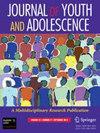Interethnic Climate and Psychological Adjustment in High School: The Role of School Belonging and Ethnic Identity.
IF 3.6
1区 心理学
Q1 PSYCHOLOGY, DEVELOPMENTAL
引用次数: 0
Abstract
School interethnic climate has interpersonal and intrapersonal implications for adolescent development, but little is known of how it influences their psychological adjustment over time, let alone what drives this influence. This study examined whether two components of identity-school belonging perceptions and ethnic-racial identity beliefs-mediate the association between 10th grade perceptions of school interethnic climate and 12th grade psychological adjustment. The analytic sample includes 849 students (50% girls; 30% Latinx, 27% White, 16% Asian/Pacific Islander, 18% Multiethnic, 6% African American/Black, 3% Other). Data were collected across three grade levels (Grade 10 ageM = 15.4 [0.52], Grade 11 ageM = 16.4 [0.52], Grade 12 ageM = 17.4 [0.52]) in three public high schools in two U.S. states. Findings indicated that school belonging, but not ethnic-racial identity, in 11th grade fully mediated the relation between school interethnic climate and later psychological adjustment. These pathways did not significantly differ between Asian American/Pacific Islander, Latinx, Multiethnic, and White students. This work highlights school belonging and ethnic-racial identity as distinct and beneficial developmental mechanisms in this context, as well as provides pragmatic school-centered implications for practice.高中族群间气候与心理调适:学校归属感与族群认同的作用。
学校的种族间气氛对青少年的发展有人际和个人的影响,但人们对它如何随着时间的推移影响他们的心理调整知之甚少,更不用说是什么驱动了这种影响。本研究考察了身份认同的两个组成部分——学校归属感和民族-种族认同信念——是否介导了10年级学生对学校种族间气候的感知与12年级学生心理适应之间的关系。分析样本包括849名学生(50%女生,30%拉丁裔,27%白人,16%亚洲/太平洋岛民,18%多种族,6%非洲裔美国人/黑人,3%其他)。数据收集在美国两个州的三所公立高中的三个年级(10年级的ageM = 15.4[0.52], 11年级的ageM = 16.4[0.52], 12年级的ageM = 17.4[0.52])。研究发现,高二学生的学校归属感,而非民族-种族认同,完全中介了学校种族间气候与后期心理适应的关系。这些途径在亚裔美国人/太平洋岛民、拉丁裔、多种族和白人学生之间没有显著差异。这项工作强调了学校归属感和民族-种族认同是这种背景下独特而有益的发展机制,并为实践提供了以学校为中心的实用意义。
本文章由计算机程序翻译,如有差异,请以英文原文为准。
求助全文
约1分钟内获得全文
求助全文
来源期刊

Journal of Youth and Adolescence
PSYCHOLOGY, DEVELOPMENTAL-
CiteScore
8.20
自引率
6.10%
发文量
155
期刊介绍:
Journal of Youth and Adolescence provides a single, high-level medium of communication for psychologists, psychiatrists, biologists, criminologists, educators, and researchers in many other allied disciplines who address the subject of youth and adolescence. The journal publishes quantitative analyses, theoretical papers, and comprehensive review articles. The journal especially welcomes empirically rigorous papers that take policy implications seriously. Research need not have been designed to address policy needs, but manuscripts must address implications for the manner society formally (e.g., through laws, policies or regulations) or informally (e.g., through parents, peers, and social institutions) responds to the period of youth and adolescence.
 求助内容:
求助内容: 应助结果提醒方式:
应助结果提醒方式:


